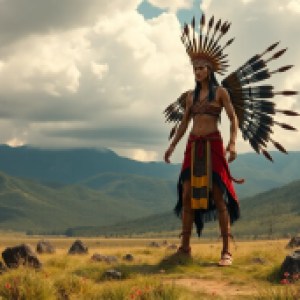Apache Myths of the Hunt: Stories of Survival and Skill
I. Introduction
The Apache people, a group of culturally rich Native American tribes, have long been renowned for their deep connection to nature and their mastery of survival skills. Central to Apache culture is the practice of hunting, which not only provided sustenance but also played a crucial role in shaping social structures and spiritual beliefs. This article delves into the myriad myths that encapsulate the Apache’s expertise in hunting, illustrating their survival skills and the profound respect they hold for the natural world.
II. The Role of Hunting in Apache Society
Historically, hunting was not merely a means of survival for the Apache; it was an integral part of their identity and community structure. The Apache tribes, including the Western Apache, Chiricahua, and Mescalero, relied heavily on hunting game such as deer, rabbits, and wild birds. This practice was essential for nutrition and played a vital role in their social fabric.
The spiritual significance of hunting in Apache life is paramount. Hunting rituals, often accompanied by ceremonies and prayers, were believed to ensure a successful hunt and to honor the animals that gave their lives. The Apache viewed themselves as stewards of the land, and their hunting practices were deeply intertwined with their cultural and spiritual beliefs.
III. Key Figures in Apache Hunting Myths
Apache mythology features numerous legendary hunters and deities that embody the skills and attributes admired within their culture. Key figures include:
- White Painted Woman: A central figure in Apache creation myths, symbolizing fertility and life.
- Goddess of Hunting: Often invoked during hunting rituals, believed to grant skill and success to hunters.
- Sun and Moon: Representing guidance and navigation, these celestial bodies were revered by hunters for their roles in marking the time and direction.
These characters are characterized by traits such as bravery, wisdom, and a profound connection to the natural world, serving as role models for hunters and community members alike.
IV. Creation Myths Related to Hunting
Apache creation myths often explain the origins of the animals they hunt and the tools they use. One such story speaks of the first deer, which was created by the Great Spirit to provide food for the people. The myths convey a sense of gratitude towards nature and highlight the importance of balance in the ecosystem.
Additionally, hunting tools such as bows and arrows are often credited to divine inspiration. The Apache believe that these tools were given to them by the spirits, thus reinforcing their responsibility to use them wisely and sustainably.
This relationship between the Apache and the natural world is foundational, emphasizing respect for all creatures and the environment that sustains them.
V. Myths of Skill and Ingenuity
Apache hunting myths are replete with tales that showcase exceptional skill, strategy, and ingenuity. These stories often highlight the following themes:
- Adaptability: Many myths emphasize the importance of adapting hunting techniques to different environments and conditions.
- Teamwork: Collaborative hunting efforts are celebrated, illustrating the value of community and cooperation.
- Resourcefulness: The use of available materials and natural resources to create tools and traps is a recurring theme in these tales.
Through these narratives, the Apache impart essential lessons about perseverance, innovation, and the necessity of learning from nature.
VI. Survival Myths and Their Teachings
Survival in the harsh landscapes of the Southwest is a prevalent theme in Apache mythology. These myths often narrate the experiences of hunters facing formidable challenges, such as extreme weather, scarcity of game, or encounters with rival tribes.
One prominent survival story tells of a young hunter who, lost in the mountains, learns to listen to the sounds of nature for guidance. He survives by deciphering the calls of birds and the movements of animals, demonstrating the importance of being in tune with the environment. This story, like many others, embeds moral lessons about resilience, intuition, and the importance of knowledge passed down through generations.
VII. Contemporary Relevance of Apache Hunting Myths
In today’s world, Apache hunting myths continue to influence modern Apache identity and practices. Many contemporary Apache communities strive to preserve their hunting traditions, recognizing their cultural significance. The stories of their ancestors serve as a source of inspiration and guidance for younger generations.
Efforts to maintain hunting practices are often accompanied by educational programs that teach the values embedded in these myths, such as:
- Respect for wildlife and nature.
- The significance of sustainability in hunting practices.
- The role of community in preserving cultural heritage.
These initiatives not only honor Apache traditions but also foster a deeper connection to their roots and the environment.
VIII. Conclusion
Apache myths surrounding the hunt are rich in cultural significance, offering profound insights into survival and skill. These narratives not only convey practical knowledge essential for hunting but also reflect the Apache’s deep respect for nature and their commitment to community values. As we explore these stories, we gain a deeper understanding of the Apache way of life and their enduring legacy in the tapestry of Native American mythology.
We encourage readers to delve further into the world of Native American mythology, exploring the myriad teachings and stories that continue to resonate with and inspire people today.



